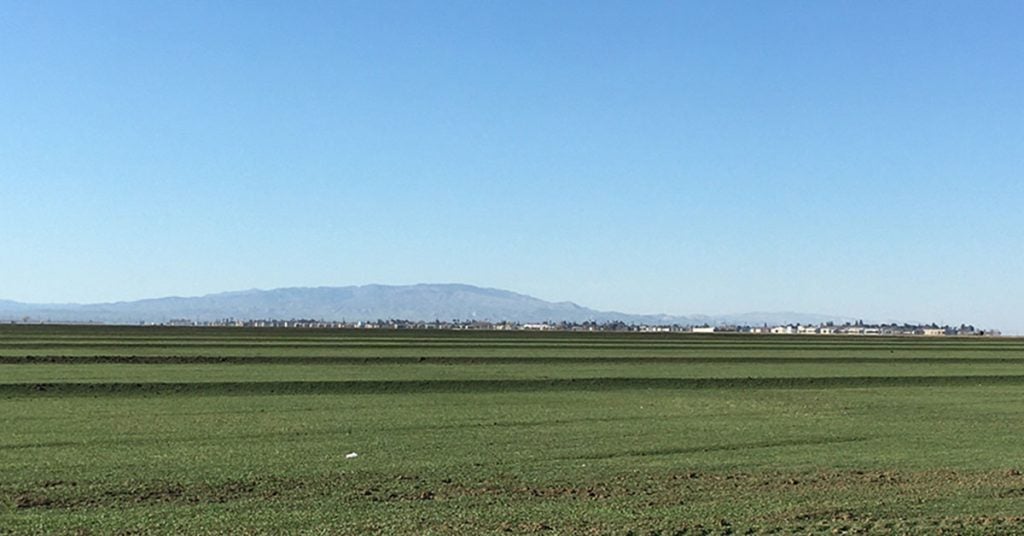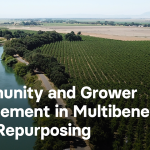 Sarah Woolf, a member of a Fresno County farm family, is standing on the edge of a field that most recently grew hemp; garlic, tomatoes and onions before that; and cotton years ago. On one side is the dry Arroyo Pasajero Creek, bushes, and a wild, scraggly tree that looks like something from a Dr. Seuss book. On the other side in the far distance is the small farming town of Huron.
Sarah Woolf, a member of a Fresno County farm family, is standing on the edge of a field that most recently grew hemp; garlic, tomatoes and onions before that; and cotton years ago. On one side is the dry Arroyo Pasajero Creek, bushes, and a wild, scraggly tree that looks like something from a Dr. Seuss book. On the other side in the far distance is the small farming town of Huron.
This former hemp field has been regraded to recharge groundwater from the creek during the next big storm in order to provide both water supply and flood control benefits. It’s an example of the kind of project that could be funded by the state’s new Multibenefit Land Repurposing Program, which launched this year with an initial $50 million. The program was created to help ease the transition for farmers to sustainable groundwater management while creating new benefits on previously irrigated land.
My colleagues and I recently visited the Arroyo Pasajero Creek and talked with Woolf and later Huron Mayor Rey León about the project and current drought. In addition to conserving water, here are three additional benefits of this land repurposing project — and one envisioned for the future — that they highlighted.

Left to right: Anna Schiller and Ann Hayden of EDF talk with Jon Reiter and Sarah Woolf of Woolf Farming Co. on the edge of former farmland that has been regraded to maximize groundwater recharge from nearby Arroyo Pasajero Creek. Woolf is part of a group of landowners who have diverted water during flood events in 2018 and 2019 to use stormwater from the creek to recharge groundwater.
The project recharges groundwater and manages flood waters.
Collectively, their land is among the few areas in the Westlands Water District (the largest water district in the nation) where the soils allow for groundwater recharge — one of many strategies that regions across California are considering to comply with the Sustainable Groundwater Management Act and respond to climate change. The landowners paid for a helicopter airborne electromagnetic study of the aquifer that found they had over 1 million acre-feet of available underground water storage.
Figuring out how to tap into that storage took time, money and persistence. The group applied for a water right from the state to access up to 13,000 acre-feet of water from the creek during peak flow events. They also obtained a license agreement with the Bureau of Reclamation, which owns the land along the creek, to gain access to three areas to divert the creek water.
The first goal of the project, says Woolf, is sustainability for these 36,000 acres of irrigated land. Second, she says, is to support the recharge necessary to support a new groundwater well for the city of Huron while also developing habitat and open space opportunities to enhance the community.
The recharge project provides a backup water supply to Huron residents.
The landowners have agreed to give Huron access to 500 acre-feet of groundwater credits for future use after the city completes the new well, which will be used as a backup drinking water supply when Huron’s surface water is limited.
Securing a backup water supply for human and ecosystems’ needs is particularly important during drought, when surface water from the federal water delivery system is reduced. This year, Huron’s allocation was reduced to 25% of its usual supply, according to León.
As Huron builds a new well, groundwater recharge should also be part of the city’s mission, León says. “I don’t think it’s smart or fair for us to just take water from the well without doing everything in our power to replace it.”
In addition to grappling with such major water cuts, Huron also has taken a big economic hit from the drought. Lettuce season used to bring 8,000 migrant workers to Huron, filling restaurants and keeping gas stations busy. Last year, there were 200 workers, and they stayed an hour away, León says.
But the city is doing its part to become more resilient and adapt to climate change, León notes. Huron was among the first cities in California to require gray water plumbing in all new housing. León also has grabbed headlines for starting an electric car rural ridesharing service called the Green Raiteros through the Leap Institute, a nonprofit he founded and leads.

Huron Mayor Rey León has developed several efforts to build climate resilience in his town of 7,600, including an electric car service called the Green Raiteros and a gray water ordinance. Next he wants to build a park along Arroyo Pasajero Creek. Photo credit: Leah Worthington
The next step: a park along the creek?
León’s even bigger vision is to turn 3,000 acres along the creek into a community park. Huron is 98.7% Latino — “the most Latino city in the U.S.” — and 51% park deficient, according to Leon. A park would address that gap and help fulfil the 30×30 goal set by the state of California to conserve 30% of all lands and coastal waters by 2030, he says.
León won a National Park Service grant and met with the Bureau of Reclamation to determine if creating a park is possible. Though initially receptive, bureau staff concluded the land can’t be turned into public space because of a former asbestos mine near the creek in the mountains.
León, however, believes mitigation is possible, based on what he knows about the soils from his work getting a bridge built over the creek to address deadly flooding. “I can see thousands of native drought-resistant trees planted there through a youth employment program,” he told us.
Such vision and persistence will be valuable attributes for leaders across California given the magnitude of the transition to groundwater sustainability, with some studies forecasting that 750,000 acres of farmland will have to be taken out of production. Creativity, collaboration, science and money — all tapped by the landowners to develop the Arroyo Pasajero recharge project — also will be needed to develop ways to use these lands that bring new benefits for communities and wildlife.
Our hope is that other regions who receive funding from the state’s new Multibenefit Land Repurposing Program can learn valuable lessons from the Arroyo Pasajero project, Woolf and León to successfully replicate their work.













One Comment
In this case it appears that the goal is sustainability within the basin – reducing extraction on order to assure the long term viability of the community. I am a little concerned by the diversion of surface water to subsidize what would otherwise be over-extraction. When we subtract surface water, we lose habitat and recreation. Does someone speak for those interests?